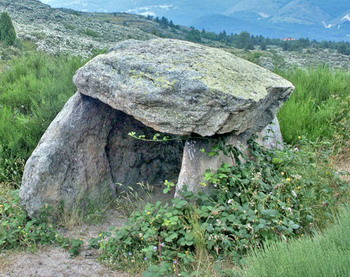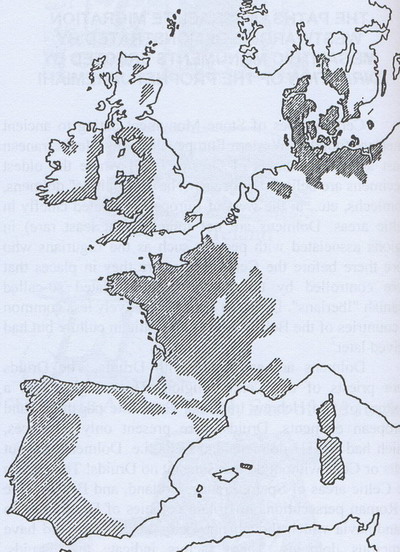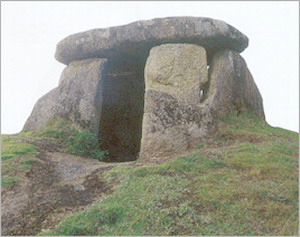Dolmen
Jeremiah (31;21) refers to
dolmens which are large stones set table fashion over others and often covered by
large piles of rocks and stone. The
dolmens and other related stone monuments form a connecting link between Israel, Britain, West France, and Scandinavia.
More dolmens (over 5000!) have been
found in Denmark than in any other country. On the other hand the oldest dolmens are believed to be those
of Israel. More than 20,000 megalithic
monuments of all types (including dolmens) have been found in the Land of Israel especially on the
eastern "Jordanian" side since for
various reasons those on the west were destroyed by local inhabitants. The verse in effects links dolmens
with Ephraim.
[Jeremiah 31:21]
"SET THEE UP WAYMARKS,
MAKE THEE HIGH HEAPS: SET THINE HEART TOWARD THE HIGHWAY, EVEN THE WAY
WHICH THOU WENTEST: TURN AGAIN, O VIRGIN OF ISRAEL, TURN AGAIN TO THESE
THY CITIES."
Hofman (Olam HaTanach): <<The
Prophet calls upon the Exiles to indicate with special signs their pathway into
Exile, in order that they may quickly
return to the land by the path they went in. This method of marking a pathway is practiced unto this day
& How would they know to find the way in Biblical Times? How would they describe
the way of journey or the border
line? It appears that in Biblical times to was accepted practice to make note of prominent features &>>
Abarbanel: <<The prophet
therefore spoke concerning the Kingdom of Israel [of the Ten Tribes] SET THEE UP WAYMARKS saying
that when you g into Exile make
signs by the routes and waymarks like piles of rocks [i.e. cairns] or stone monuments [Hebrew: Matzavah, i.e. dolmen]
so that you may set your heart to
the route and remember in order that you may return in the way you went in, return to your city.>>
The WAYMARKS the Prophet is referring
to were megalithic monuments. These monuments we believe were set up by Israelites
and we have some proof for this
belief. Even however if the monuments in question were not set up by Israelites but had existed previously the fact
remains that they happened to all
lie along the path of Israelite migration westward. It is this fact that Jeremiah is telling the Israelites (i.e.
he is telling us) to take note
of.
The word translated above as "WAYMARKS"
in the original Hebrew is "Tzionim"
which strictly speaking means "signs" but in spoken Hebrew is usually used to denote a stone erection marking
a grave or event.
The most literal explanation of
this verse amongst the Classical Authoritative
Rabbinical Commentators is that given by the "Radak" (Rabbi David Kimchi, 1157-1236) of Narbonne,
France. The Radak says:
"SET YOURSELF UP WAYMARKS"
(Jeremiah 31): This was directed to the Community of Israel, that in the generation
when they would be exiled they should
set up waymarks [i.e. "tsionim"] such as PILED-UP STONES OR STONE MONUMENTS. The purpose of these monuments
was to mark the paths [of migration
for the sake of future recognition]. The meaning was to say that even though you will be exiled, hope is not lost
and you are still destined to return
to these your cities. "MAKE YOURSELF HIGH HEAPS" [Hebrew: "tamrurim"]. The same message is repeated though
the wording is changed since both
"tamrurim" [i.e. "high heaps"] and "tsionim" (i.e. "waymarks") connote elevated-height [from the root "tamar"]...
Bearing in mind that according to
the previous verse (31;20) Jeremiah
is addressing himself to Ephraim, the verse in Jeremiah 31;21 may therefore be understood to say:
Jeremiah 31:21
"Set yourself up stone monuments
[menhirs, dolmens] and high heaps of stones [cairns]
[i.e. Megalithic monuments!]. Set your heart towards the prepared way:
The way in which you went. Turn back o virgin of Israel, return unto these
cities of yours."
The mode of expression employed
by the Prophet should be understood
differently from that used by Moses. When Moses gave a
commandment it had to be obeyed.
When the prophets issue an order concerning future action it means they are predicting
what will happen. They are telling
us what must be learned from this action. Jeremiah is saying that (for whatever reason) the exiled Israelites
will have stone monuments set up.
Through these monuments Jeremiah predicts that it will be possible in the future to learn of the Israelite
paths of migration away from the
Land of Israel. Once this is learned it will serve as a means by which they may be persuaded to return. The inferred
commandment to the exiles to erect
"Tsionim" is therefore applicable to the dolmens and other so called "Stone Age" ("Megalithic") monuments.
Many of these monuments date from
the Bronze and Iron Age periods. They are mentioned in the Bible as being set up by the Hebrew Patriarchs and Judges
as well as by others.
The ancient Israelites were always familiar with bronze and iron utensils but it should be noted that in
some cases the use of stone
only was enforced. An altar had
to be erected of whole unhewn stones (Exodus 20;22); "An altar of whole stones over
which no man hath lift up any iron"
(Joshua 8;31). Joshua was commanded to circumcise Israelites born in the wilderness with "knives of flint" (Joshua
5;2-3). The Hebrew has "Charvoth
Tsurim" which the KJ imprecisely translates as "sharp knives". "Tsur" means flint or sharp stone.
Dolmens and related monuments
are found in the Land of Israel, in Jordan, in the Caucasus, in Spain, Brittany
(France), Britain, and Scandinavia.
There are several types of dolmens
and examples have also been reported
from Ethiopia, Japan and India. Eastern dolmens are somewhat different from those of Israel and the west.
Even so in India the dolmens are
linked with legends of green-eyed Vikings and with the Lost Ten Tribes.
The type of dolmen found in the
area of ancient Israel (on both sides of the Jordan River) is the same as that found
in Western Europe:
"The megalithic dolmens found
in the Golan and Galilee are table
like structures composed of two vertical basalt blocks roofed by large rock slabs. A heap of stones usually covered
the dolmens, creating a tumulus.
Such structures are known in Transjordan from the Chalcolithic period, but in the Golan and Galilee they definitely
date to EB [i.e. Early Bronze] IV
/MB [Middle Bronze] I...These dolmens recall similar megalithic burial structures known throughout Europe in
the Bronze Age, but the significance
of this resemblance is unclear". A. MAZAR, Archaeology of the Land of the Bible, U.S.A. 1990.
p.160.
The conventional dating applied
in Europe to dolmens and the like
is too early. Most Megaltihic monuments in Western Europe were erected
in the Late Bronze or Early Iron
Age after the Israelites had been exiled. People of Israelite origin erected them! In
archaeological and historical studies
of Western Europe dolmens are associated with the Celtic Druids. Wherever Celts and Druids were found together,
so too, were there dolmens.
Iron age artifacts are frequently
found together with or in the vicinity
of dolmens. Iron was largely introduced to Europe after 700 BCE with the coming of the Celts. Some of the
Israelite groups used bronze tools,
some reverted to stone-age ones (as did the Dutch Boers in South Africa in the 1700s), but on the whole the migrating
Israelites may be associated with
iron.
Through Dolmens a good case may
be made for tracing the migrations
of the Lost Ten Tribes to Western Europe. The quoted verse of Jeremiah may well be understood in this sense.
The word "Tamrurim" used by
Jeremiah (translated here as "high heaps") in Modern Hebrew is the word used for
"Traffic sign" or
"wayfare indicator". WAYMARKS, as
noted, equal dolmens. The verse (Jeremiah 31;12) may therefore in the Hebrew be understood
further as saying:
"Establish waymarks [i.e. "Tsionim"
=dolmens] for yourself, set up
for yourself high-heaps [i.e. cairns, "Tamrurim" = wayfare markers]: put your heart [i.e. pay attention] to the pathways
you went by and return, O virgin
of Israel, come back to these cities of yours.
Some understand the above verse
in a partly figurative sense but
taken literally according to the Radak (Kimchi) it means that a trail of megalithic monuments should be traceable along
the paths of migration as indeed
it is. Megalithic Monuments begin in the land of Israel on both sides of the Jordan. They have offshoots of uncertain
nature into Asia but exact reproductions
are fund in the Caucasus, in Bulgaria, in Spain, West France, the Netherlands, Scandinavia, Britain,
and Ireland. They describe two
main migratory paths from Israel to Western Europe. These paths show us
how the Lost Ten Tribes left their
land and where they went to. Jeremiah
the Prophet transmits the command
of God telling us to take heed of the paths we went in, the monuments we set up, and
the way leading back to the cities
of our forefathers in the Land of Israel.
[Jeremiah 31:22]
HOW LONG WILT THOU
GO ABOUT, O THOU BACKSLIDING DAUGHTER? FOR THE LORD HATH CREATED A NEW
THING IN THE EARTH, A WOMAN SHALL COMPASS A MAN.
Abarbanel on this verse says it
refers to the Ten Tribes who at first would be weak like a woman but later would gain strength
like a man and overcome the Gentiles.
Radak: <<A WOMAN SHALL COMPASS
A MAN: It is the way of the world that a man goes after and hangs around a woman, as the
sages said: Someone who has lost
something seeks after what he is lacking. Here the female goes after and around the man, that is the Children of
Israel will repent and return to
their God who will redeem them>>.
The expression A WOMAN SHALL COMPASS
A MAN is considered an allegory to the Children of Israel attempting to return to God,
as if Israel is symbolized by a
female wooing her man who is the God of Israel. For the last few years
I have been studying the Book of
Jeremiah in a weekly class given by Rabbi Mordecai Machles in Jerusalem. Rabbi Machles
has pointed out that today it
is becoming acceptable for a female
to initiate courtship with a male. In the past this was unthinkable. Rabbi Machles
suggests that this development is
connected with the expression in Jeremiah, A WOMAN SHALL COMPASS A MAN,
and that this is a sign that the
prophecies of Jeremiah are about to be fulfilled.
A WOMAN SHALL COMPASS A MAN: In
Hebrew it can be said to mean that a woman shall surround a man. The Rabbis said (Yebamot
62) that a person should get married.
Every one without a wife dwells without happiness; without blessing, without goodness etc. In Israel they
said, without Torah, without a wall
[to protect him from temptation] as it says, A WOMAN SHALL COMPASS A MAN.
On a symbolic level this verse
has been applied to the Lost Ten Tribes who will initiate an approach to Judah to which
Judah will reply. Brit-Am serves
as a connecting link between Judah and Joseph. If you agree with the goals of Brit-Am send us an offering to enable
us to go forward.
We repeat:
The exhortation in Jeremiah:
[Jeremiah 31:21]
SET THEE UP WAYMARKS,
MAKE THEE HIGH HEAPS: SET THINE HEART TOWARD THE HIGHWAY, EVEN THE WAY
WHICH THOU WENTEST: TURN AGAIN, O VIRGIN OF ISRAEL, TURN AGAIN TO THESE
THY CITIES.
This refers specifically to the
so-called megalithic monuments such as dolmens BUT in general it also means that those
who have been called out of the
Lost Ten Tribes and have become aware of Brit-Am truth are commanded to
support historical research (including
archaeological reports, etc) that confirm this truth. These too, are waymarks that must be set up as evidence.
 Previous
Previous

 Previous
Previous





 Previous
Previous
